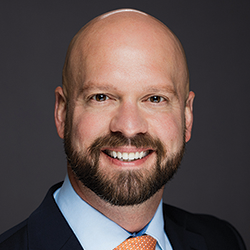
Voice of the President | March 2023

For at least two decades, we have heard the labor predictions and are now feeling the implications of an international nursing shortage. Researchers who study workforce trends forecasted many years ago that we would experience a significant deficit in the supply versus the demand of health care workers, more
specifically nurses. In 2020, the COVID-19 pandemic was a shock to the system and threw us curve balls. Suddenly the predictions related to the number of nurses graduating, going part time, retiring or leaving the profession were no longer as reliable – and neither were the strategies to address these trends.
As a result of examining new workforce shortage prediction models, many nurse leaders are exploring various strategies to sustain and expand their ability to care for their communities. The solutions to workforce challenges are complex and require silos to be broken and interprofessional partnerships to occur. Health care leaders need to take a hard look, examining why we are in this current state.
Moreover, highlighting the joy that exists within our profession remains a priority. Keeping (or in some cases. restoring) joy in a clinician’s day must be at the heart of everything we do. The programs, initiatives and strategies we are developing and implementing across health care are about more than improving efficiencies, building a robust pipeline and slowing turnover. The goal and expected outcome of these efforts is to restore enough time and space for individuals on our teams to practice mindfulness and self-care on a consistent basis and (re)identify the joy in what we do.
Keeping joy in a clinician’s day must be at the heart of everything we do.
This month’s Voice of Nursing Leadership topic on recruitment and retention contains some great examples of how organizations have reimagined their onboarding practices, professional development programs and retention strategies. This topic is near and dear to many of our hearts and is becoming an everyday priority in the life of nurse leaders. In my own organization, Norton Children’s Hospital in Louisville, Ky., our 2022-2023 nursing strategic plan has been solely dedicated to mitigating some of the workforce challenges we’re facing.
A few weeks ago I met with some of my leaders to revisit the original plan developed in January 2022. It was reassuring to see the progress we have made and to hear our strategies remain relevant and are consistent with input from our front-line teams. Our three foci are centered on professional development (including transition to practice), staffing and scheduling, and employee well-being. These three topics encompass a wide range of strategies including flexible scheduling options, implementing a code lavender response team, redesigning our onboarding program to incorporate more adult learning practices, preventing workplace violence and starting a mentor-mentee program.
I would be remiss if I didn’t mention that this month’s topic also aligns perfectly with the efforts of AONL’s Workforce Committee. Since its inception in January of 2022, the Workforce Executive Steering Committee has met on a weekly basis and the full committee has met bi-weekly. Rapidly, the team identified seven main areas of focus to help leaders address some of the workforce issues we are facing. Selecting seven areas of focus is a reflection of the complex, multifaceted nature of this problem. Recognizing time was of the essence, we quickly formed seven subcommittees, one dedicated to each of the identified focus areas.
The committee and subcommittee efforts were aligned with AONL’s vision to be “one voice advancing health for all.” Together the committee determined the aim would be to serve as the conduit for organizing and disseminating best practices and innovations from nursing leaders across the nation. We agreed to develop and release three compendiums to support and empower nurse leaders in attaining, retaining and sustaining environments where nurses want to work and feel they belong.
Our first compendium section focused on attracting, acquiring, recruiting and retaining nursing leadership came out in December 2022. The second section, released in January, is dedicated to leadership and positive practice environments. The third section with foci on academic-practice partnerships, culture of inquiry and total rewards was published last month. The full compendium represents dozens of best practices and innovations to help support nurse leaders.
I beam with pride when I talk about the engagement and commitment from the Workforce Committee! Despite having their own responsibilities, committee members, led by Deb Zimmermann and Claire Zangerle (fondly called Team Z!) managed to quickly convene, strategize and develop a series of needed tools to support nursing and health care leaders in navigating the challenges ahead.
For more discussion about these critical topics, I hope to see you at AONL 2023 May 1-4 where nurse leaders will gather to share their challenges, learn about solutions and make meaningful connections.
I want to close my column this month with a note of gratitude for all of you who donated to the AONL Foundation. Our 2022 Honor Roll is included in this month’s edition. Through generous donations from our members and corporate partners last year our foundation made some impressive contributions to support nursing leadership research, including funding the fourth AONL Nursing Leadership Insight Study. The Foundation also continues awarding financial aid for the AONL Nurse Fellowship programs. I know we all have our own philanthropic priorities we consider each year. I hope this year you will consider adding the AONL Foundation to your giving portfolio. Their efforts are making an incredible impact for the future of nursing leadership!


